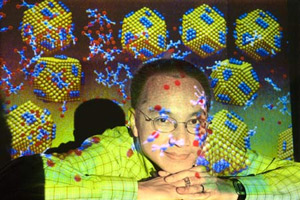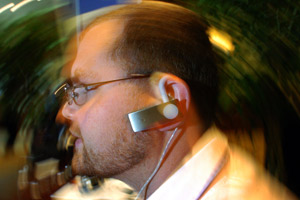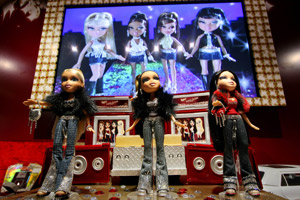Focus on America
Young Innovator Profile: Michael Wong

Describing his idea to use gold to clean up toxic waste, Michael Wong says, "I admit it does sound crazy." Wong plans to combine gold with palladium — an even more precious metal — to treat polluted groundwater beneath waste dumps and contaminated factories and military sites. "It not only works faster [than current methods], but a hundred times faster," Wong says, "and I bet it will be cheaper too."
A golden detergent? Here is Wongs trick: He creates nanoparticles of gold. In his realm, the work product is measured not in carats but in atoms. A thimbleful of coffee-colored solution contains 100 trillion gold spheres — each only 15 atoms wide, or about the width of a virus. Upon every golden nanosphere, Wong and his team dust a dash of palladium atoms. Think of an infinitely small ice cream scoop flecked with sprinkles.
The 35-year-old graduate of the California Institute of Technology and the Massachusetts Institute of Technology saysWong had not given toxic waste much thought until three years ago, when one of his colleagues at Rice University (where he is a recently tenured professor of chemical engineering) came to him and said, "I have a problem," meaning something interesting to work on.
The problem concerned the suspected carcinogen trichloroethene, or TCE, "one of the most ubiquitous pollutants out there," says Wong, and "a really nasty molecule." The clear, sweet-smelling solvent has been used for decades to degrease metal parts in factories and government facilities.
TCE lingers like a bad houseguest, especially if handled carelessly. It accumulates in soil and can persist for years in groundwater. In a report last year, the National Research Council found that TCE was a potential cause of kidney cancer; its also associated with liver problems, autoimmune disease, and impaired neurological function.
Currently, the most common method of removing TCE from groundwater is to "pump and treat," Wong says — to pump the water out of the ground and run it through a filter made of activated carbon. The carbon grains soak up TCE like a sponge, but the process leaves behind TCE-laden filters that have to be stored or burned. "So you haven really gotten rid of anything," Wong says. "Youve just moved it from one place to another."
This is where Wong comes in. He began thinking about using nanoparticles as a catalyst to react with the TCE and break it down into what he calls "happy by-products."
From the scientific literature, Wong knew that palladium had shown some promise at deconstructing TCE. So he and his team began trying various recipes, and after six months reached a eureka moment when they sculpted a palladium-covered core of gold atoms.
"We didn believe it at first, because the gold-palladium nanoparticles were just so much more efficient — like, a hundred times more efficient," he says. "You see, gold itself doesn do anything to TCE." But something very interesting happens at the interface where gold, palladium, and TCE meet.
Wongs nanodetergent breaks down TCE into relatively harmless ethane and chloride salts. He and his team are now working with engineers to build a real-sized reactor to field-test the nanoparticles at a polluted site. They hope to be scrubbing TCE in about a year, and then theyll see whether they have the cost-efficient cleaner they seek.
Wong was born in Quebec City, Quebec, and grew up in Sacramento, California. His father owned a strip mall where a tenants dry-cleaning business became contaminated with a chemical cousin of TCE. Wong said his father was held legally responsible and fined tens of thousands of dollars. "So my dad has a real interest in my work," said Wong. "He keeps telling me, Hurry up, son!"
Recently on Focus on America
Innovation Transfers Benefit Public and Private Sectors
 Fashion design that might one day be adapted to protect the Army?
Fashion design that might one day be adapted to protect the Army?
That is possible because of innovative work by a Cornell University student whose design has caught the eye of U.S. Army scientists. Designer Olivia Ong put together two ensembles using silver nanoparticles in 2007 to eliminate health threats from microbes. The garments also incorporate palladium nanoparticles designed to reduce the effects of air pollutants.
From an Iranian Childhood of More Work than Play, a Tycoon Rises
 Were you to talk to Isaac Larian about his childhood in Iran, he would not wax nostalgic over childhood games or playthings. In fact, he would tell you that when his friends and cousins played or went on vacation, he did 'constant, hard work' helping his father run a retail textile business.
Were you to talk to Isaac Larian about his childhood in Iran, he would not wax nostalgic over childhood games or playthings. In fact, he would tell you that when his friends and cousins played or went on vacation, he did 'constant, hard work' helping his father run a retail textile business.
African Americans' Struggles, Triumphs Shown in Photo Exhibition
 An exhibition of 100 striking black-and-white photographs evokes the personal stories and hard-won victories of influential African Americans who helped shape the life of their nation over the past 150 years.
An exhibition of 100 striking black-and-white photographs evokes the personal stories and hard-won victories of influential African Americans who helped shape the life of their nation over the past 150 years.